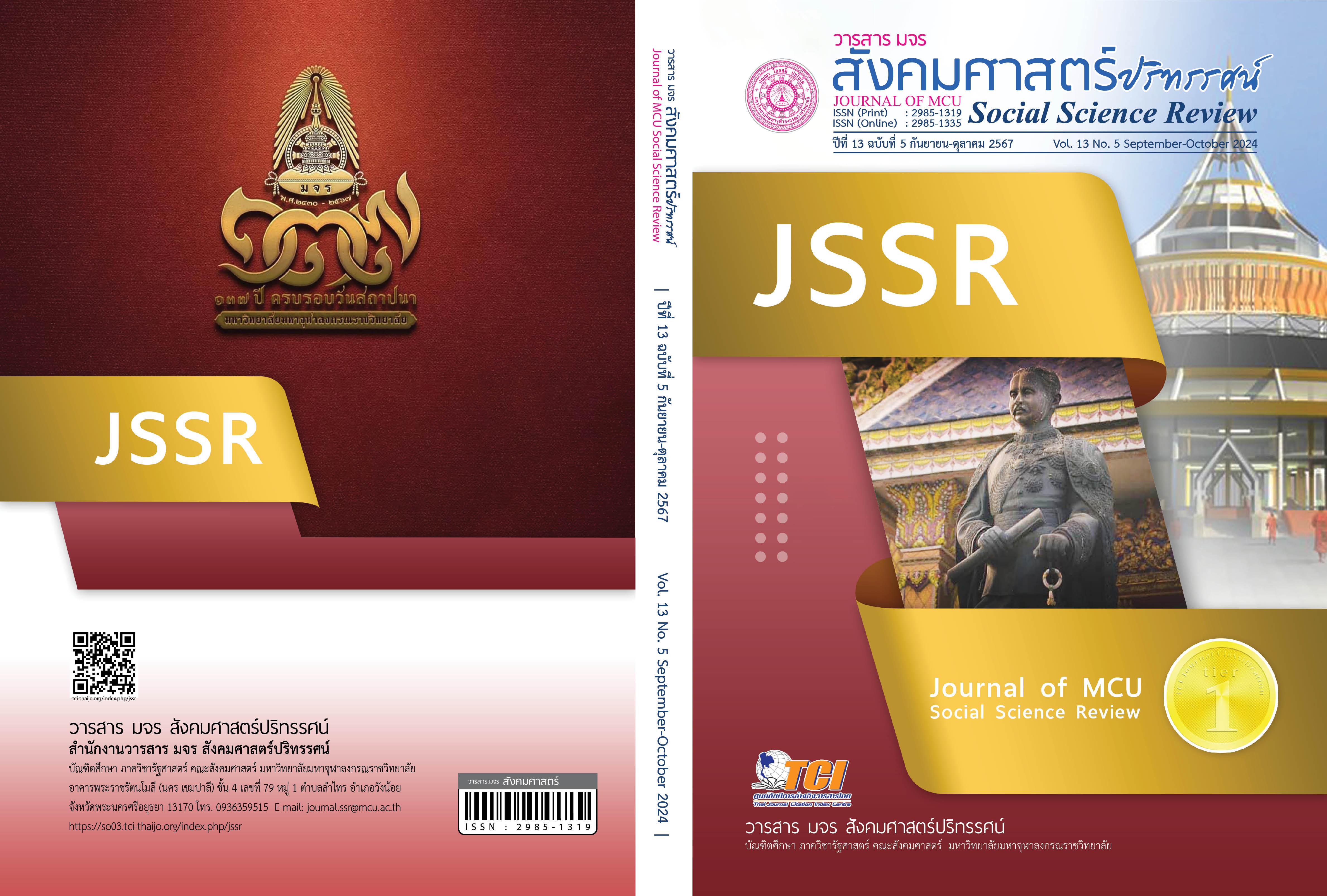การพัฒนาหลักสูตรเสริมทักษะนาฏศิลป์ไทยของนักเรียนชั้นมัธยมศึกษาปีที่ 1 สังกัดสำนักงานเขตพื้นที่การศึกษามัธยมศึกษากาฬสินธุ์
คำสำคัญ:
การพัฒนาหลักสูตร, ทักษะนาฏศิลป์ไทย, นาฏศิลป์สร้างสรรค์, คุณค่าวัฒนธรรมไทยบทคัดย่อ
บทความวิจัยนี้มีวัตถุประสงค์เพื่อพัฒนาหลักสูตรเสริมทักษะนาฏศิลป์ไทยของนักเรียนชั้นมัธยมศึกษาปีที่ 1 สังกัดสำนักงานเขตพื้นที่การศึกษามัธยมศึกษากาฬสินธุ์ โดยใช้รูปแบบการทดลองโดยมีกลุ่มตัวอย่าง คือ นักเรียนชั้นมัธยมศึกษาปีที่ 1 โรงเรียนอนุกูลนารี จำนวน
42 คน เครื่องมือที่ใช้เก็บข้อมูล ได้แก่ แบบทดสอบความรู้ และแบบสอบถาม วิเคราะห์ข้อมูลโดยสถิติ ร้อยละ ค่าเฉลี่ย ส่วนเบี่ยงเบนมาตรฐาน และทดสอบสมมติฐานด้วย t-test (Dependent Samples)
ผลการวิจัยพบว่า หลักสูตรที่พัฒนาขึ้นประกอบด้วย 1. หลักการ 2. วัตถุประสงค์ 3. เนื้อหา 4. กิจกรรมการเรียนรู้ 5. การประเมินผล บูรณาการกระบวนการสอนทักษะปฏิบัติและการเห็นคุณค่าวัฒนธรรมไทย ด้วยกระบวนการเรียนรู้ 5 ขั้นตอน ได้แก่ ขั้นการเตรียมความพร้อม ขั้นปฏิบัติทักษะตามแบบ ขั้นแสดงออกอย่างชำนาญ ขั้นสร้างสรรค์การออกแบบ ขั้นประเมินและปรับปรุงการตรวจสอบคุณภาพหลักสูตร พบว่า มีความเหมาะสมและมีความสอดคล้องตามเกณฑ์ คะแนนที่ได้จากการเรียนด้วยหลักสูตรนี้มีประสิทธิภาพ (E1/E2) เท่ากับ 87.23/88.45 ซึ่งเป็นไปตามเกณฑ์ที่กำหนดไว้ นอกจากนี้ ผลการใช้หลักสูตร พบว่า เครื่องมือประกอบหลักสูตรมีความสอดคล้องและมีความเชื่อมั่น ผลการประเมินทักษะนาฏศิลป์ไทยสร้างสรรค์ประกอบด้วย ความรู้ทางนาฏศิลป์หลังเรียนสูงกว่าก่อนเรียนมีความสามารถพื้นฐานทางนาฏศิลป์และความสามารถในการออกแบบนาฏศิลป์สร้างสรรค์อยู่ในระดับมากที่สุด
อย่างมีนัยสำคัญทางสถิติที่ระดับ .05
เอกสารอ้างอิง
กระทรวงศึกษาธิการ. (2551). หลักสูตรแกนกลางการศึกษาขั้นพื้นฐาน พุทธศักราช 2551 (พิมพ์ครั้งที่ 3). กรุงเทพฯ: โรงพิมพ์ชุมนุมสหกรณ์การเกษตรแห่งประเทศไทย จำกัด.
ฉวีวรรณ ตาลสุก. (2556). การพัฒนาหลักสูตรนาฎศิลป์สร้างสรรค์ตามแนวทางการจัดการศึกษาเชิงสร้างสรรค์สำหรับนักเรียนชั้นประถมศึกษา (ดุษฎีนิพนธ์ปรัชญาดุษฎีบัณฑิต สาขาวิชาหลักสูตรและการสอน). กรุงเทพฯ: มหาวิทยาลัยศิลปกร.
มนตรี วงษ์สะพาน. (2554). การพัฒนาหลักสูตรฝึกอบรมครูในการสร้างนวัตกรรมบทเรียน คอมพิวเตอร์มัลติมีเดียที่เน้นกระบวนการคิดวิเคราะห์ (ดุษฎีนิพนธ์การศึกษาดุษฎีบัณฑิต สาขาวิชาการวิจัยและพัฒนาหลักสูตร). กรุงเทพฯ: มหาวิทยาลัยศรีนครินทรวิโรฒ.
วิชัย วงษ์ใหญ่. (2523). เอกสารประกอบการเรียนกิจกรรมสร้างสรรค์สำหรับเด็กก่อนวัยเรียน. กรุงเทพฯ: มหาวิทยาลัยศรีนครินทรวิโรฒ.
สำนักงานคณะกรรมการพัฒนาการเศรษฐกิจและสังคมแห่งชาติ สำนักนายกรัฐมนตรี. (2560). สรุปสาระสำคัญแผนพัฒนาเศรษฐกิจและสังคมแห่งชาติฉบับที่สิบสอง พ.ศ. 2560-2564. กรุงเทพฯ: สำนักงานคณะกรรมการพัฒนาการเศรษฐกิจและสังคมแห่งชาติ สำนักนายกรัฐมนตรี.
สงัด อุทรานันท์. (2532). พื้นฐานและหลักการพัฒนาหลักสูตร (พิมพ์ครั้งที่ 3). กรุงเทพฯ: โรงพิมพ์มิตรสหาย.
บุญชม ศรีสะอาด. (2553). การวิจัยเบื้องต้น (พิมพ์ครั้งที่ 8). กรุงเทพฯ: สุวีริยาสาส์น.
อัคพงศ์ สุขมาตย์. (2553). การพัฒนาหลักสูตรเสริมสร้างคุณลักษณะที่พึงประสงค์ของ นักเรียน ชั้นประถมศึกษาปีที่4 ตามแนวคิดจิตตปัญญาศึกษา (ดุษฎีนิพนธ์การศึกษาดุษฎีบัณฑิต สาขาวิชาการวิจัยและพัฒนาหลักสูตร). กรุงเทพฯ: มหาวิทยาลัยศรีนครินทรวิโรฒ.
Oliva, P. F. (1992). Development the Curriculum (3rd ed.). New York: Harper Collins.
Saylor, G. J. et al. (1981). Curriculum Planning for Better Teacher and Learning (4th ed.). New York: Holt Rinehart and Winston.
Taba, H. (1962). Curriculum Development Theory and Practice. New York: Harcourt, Brace and World.
Tyler, R. W. (1949). Basic Principia of Curriculum and Instruction. Chicago: the University of Chicago press.
ดาวน์โหลด
เผยแพร่แล้ว
รูปแบบการอ้างอิง
ฉบับ
ประเภทบทความ
สัญญาอนุญาต
ลิขสิทธิ์ (c) 2024 วารสาร มจร สังคมศาสตร์ปริทรรศน์

อนุญาตภายใต้เงื่อนไข Creative Commons Attribution-NonCommercial-NoDerivatives 4.0 International License.
เพื่อให้เป็นไปตามกฎหมายลิขสิทธิ์ ผู้นิพนธ์ทุกท่านต้องลงลายมือชื่อในแบบฟอร์มใบมอบลิขสิทธิ์บทความให้แก่วารสารฯ พร้อมกับบทความต้นฉบับที่ได้แก้ไขครั้งสุดท้าย นอกจากนี้ ผู้นิพนธ์ทุกท่านต้องยืนยันว่าบทความต้นฉบับที่ส่งมาตีพิมพ์นั้น ได้ส่งมาตีพิมพ์เฉพาะในวารสาร มจร สังคมศาสตร์ปริทรรศน์ เพียงแห่งเดียวเท่านั้น หากมีการใช้ภาพหรือตารางหรือเนื้อหาอื่นๆ ของผู้นิพนธ์อื่นที่ปรากฏในสิ่งตีพิมพ์อื่นมาแล้ว ผู้นิพนธ์ต้องขออนุญาตเจ้าของลิขสิทธิ์ก่อน พร้อมทั้งแสดงหนังสือที่ได้รับการยินยอมต่อบรรณาธิการ ก่อนที่บทความจะได้รับการตีพิมพ์ หากไม่เป็นไปตามข้อกำหนดเบื้องต้น ทางวารสารจะถอดบทความของท่านออกโดยไม่มีข้อยกเว้นใดๆ ทั้งสิ้น





